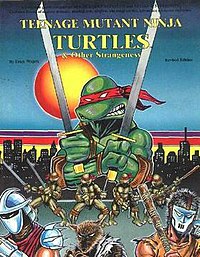Teenage Mutant Ninja Turtles & Other Strangeness
| Designer(s) | Erick Wujcik |
|---|---|
| Publisher(s) | Palladium Books |
| Years active | September 1985 – January 2000 |
| Genre(s) | Science fiction, superhero |
| System(s) | Megaversal |

Cover of Teenage Mutant Ninja Turtles role-playing game core rulebook
|
|
| Author | Erick Wujcik |
|---|---|
| Illustrator | Peter Laird, Kevin Eastman |
| Cover artist | Kevin Eastman |
| Country | United States |
| Language | English |
|
Publication date
|
September 1985 |
| Media type | Print (paperback) |
| Pages | 112 |
| ISBN | |
| Followed by | Teenage Mutant Ninja Turtles Adventures |
Teenage Mutant Ninja Turtles & Other Strangeness is a role-playing game based on the comic book created by Kevin Eastman and Peter Laird. The core rulebook was first published by Palladium Books in September 1985 – a couple years before the Turtles franchise achieved mass popularity – and featured original comic strips and illustrations by Eastman and Laird. The rules and gameplay are based on Palladium's Megaversal system. Some of these rules, outlining the basics of character creation and providing a short list of animal options, were later incorporated in the second edition of Heroes Unlimited.
Turtles and rats were not the only option for mutated animals; a rather large list was made available of animals that could be mutated in a wide variety of ways (intelligence, human looks, functioning hands, bipedalism, etc.). Some animals allowed access to different varieties (most notably dog breeds), and rules allowed for the creation of new animals. Characters had access to psionic powers and could come from a wide variety of sources (e.g., natural mutation or man-made experiments), as well as a variety of educational backgrounds.
The mutant animal player characters in the game lived in the modern world, functioning on the fringes of human society. One of the more innovative details of the game was the alignment system which used qualitative terms like "principled" and "miscreant" along with a list of diagnostic behaviors such as "would kill an innocent bystander" or "would never accept stolen property". These hypothetical behaviors pegged a character as fitting one of the particular alignment terms.
The original TMNT game partially mirrored the universe of the TMNT comic books and provided statistics for the Turtles, The Shredder, and other characters from early in the series. However, the adventures included with the book were completely independent of the TMNT universe, and brand-new characters were also introduced.
...
Wikipedia
